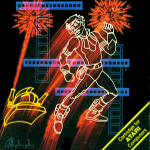|
I've spent the last few weeks catching up on this thread, some absolutely fascinating conversations and information, and now I'm hooked on reading up on the older 8 and 16-bit computers from the 80s and 90s like the Amigas and MSX series. A question for those of you who are willing to answer please! In the 80s, Commodore and Atari (and pretty much everyone else) used a form factor in which everything was all-in-one, or at the very least, the guts were contained underneath the case with the keyboard. What was the computing power like of these early home micro computers/PCs vs something like the IBM 5150 and later models? I'm thinking that it's to do with the segments and pricepoints that they were aimed at, but what strikes me most is just how big the IBM cases were. I'm not sure if I've articulated my thoughts and questions properly as it's rather late, but any input by anyone interested in explaining would be really appreciated.
|
|
|
|

|
| # ? Apr 28, 2024 21:36 |
|
fappenmeister posted:I've spent the last few weeks catching up on this thread, some absolutely fascinating conversations and information, and now I'm hooked on reading up on the older 8 and 16-bit computers from the 80s and 90s like the Amigas and MSX series. Well the Commodore 64 and Vic-20 ran at like a single megahertz. The model numbers stood for how much RAM they had (64kb versus 20kb). So they were pretty slow. The IBM PC, released around the same time as the Vic-20, had a 4.77mhz processor. It's base RAM was 20kb, but it could be expanded to something like 256kb. The price difference was massive. The IBM probably cost like 5 to 6k dollars in 1982 dollars (maybe three times that now). The Commodore 64 sold for around $500. But even without the price difference, it probably wasn't possible to squeeze an IBM PC's performance into a keyboard all-in-one and you'd lose expandability, which you wanted when you just spent $15k on a computer. I had a Commodore 64, but traded it to a friend for his Vic-20 because he had more games and my 64 was mostly a paperweight because I couldn't afford software. I later saved all my birthday and Christmas money up and wanted to buy a SNES, but my mom made me put it towards an IBM PCjr she was purchasing. So yeah, my childhood loving sucked.
|
|
|
|
Krispy Wafer posted:Well the Commodore 64 and Vic-20 ran at like a single megahertz. The model numbers stood for how much RAM they had (64kb versus 20kb). So they were pretty slow. The IBM PC, released around the same time as the Vic-20, had a 4.77mhz processor. It's base RAM was 20kb, but it could be expanded to something like 256kb. Your childhood sucked so bad it gave you brain damage. VIC-20 had 5 Kb RAM, 3.5Kb free for BASIC code. It had a20Kb ROM. The IBM PC Model 5150 had a base RAM of 16Kb, but by the time home users were buying them in earnest you'd be hard pressed to find one with less than 256Kb, and most models sold around then would be the 5160 "XT" model. Sorry you didn't have that friend with a c64, a modem and who was willing to copy tapes for you. (I didn't either, it sucked)
|
|
|
|
dobbymoodge posted:Your childhood sucked so bad it gave you brain damage. VIC-20 had 5 Kb RAM, 3.5Kb free for BASIC code. It had a20Kb ROM. The IBM PC Model 5150 had a base RAM of 16Kb, but by the time home users were buying them in earnest you'd be hard pressed to find one with less than 256Kb, and most models sold around then would be the 5160 "XT" model. It was pretty awful. I almost said the Commodore 64 was 64mhz because my brain is no longer able to parse the proportionally tiny capabilities of these old computers. One megahertz is almost impossible to comprehend. Like before that you had to measure your CPU power in hertz. I do recall wishing I had 512kb of RAM for years. Like that was an aspirational level I didn't think I'd ever get to. Because if you have 512kb of RAM you could run Windows 1 and if you had Windows you could run Balance of Power.
|
|
|
|
In 1987 there was the Tandy 1000 EX that was an all in one design similar to the c64 and VIC in that the guts of the machine and the keyboard were housed in one unit, but the difference was that the unit was much longer than those, and meant to stack a monitor on top of it. It was also $1000 instead of $500ish.
|
|
|
|
Krispy Wafer posted:It was pretty awful. I almost said the Commodore 64 was 64mhz because my brain is no longer able to parse the proportionally tiny capabilities of these old computers. One megahertz is almost impossible to comprehend. Like before that you had to measure your CPU power in hertz. CPUs running above 66 MHz didn't happen until the Pentium came around. (It's possible that RISC chips ran faster sooner, though)
|
|
|
|
TotalLossBrain posted:CPUs running above 66 MHz didn't happen until the Pentium came around. (It's possible that RISC chips ran faster sooner, though)  I'd like a megahertz counter like that on a modern PC.
|
|
|
|
TotalLossBrain posted:CPUs running above 66 MHz didn't happen until the Pentium came around. (It's possible that RISC chips ran faster sooner, though) That's not correct. There were late model 486DX chips at 80 and 100, and the Cyrix M1 was also 100MHz.
|
|
|
|
Krispy Wafer posted:
I honestly kind of would, I've always been vaguely curious about how my computer throttles my processor when it's idle and poo poo.
|
|
|
|
Krispy Wafer posted:I'd like a megahertz counter like that on a modern PC. On those old ones it just switched between two numbers that you set via dip switches and had no relation to what the CPU was actually running at.
|
|
|
|
Krispy Wafer posted:
How did those 7-segment displays get their signal? I recall that most of those front connections (Reset/PWR/HDD LED, etc) worked much like they do now, but often not as neatly organized. Did the mainboard have a 7-seg encoder chip on it? Or was it built into the front and the user could select between a couple of pre-programmed numbers? I do not remember. Edit: nvm, poster above me answered it.
|
|
|
|
Jedit posted:That's not correct. There were late model 486DX chips at 80 and 100, and the Cyrix M1 was also 100MHz. You're right, but I think they weren't released until after the Pentium came around at those clock speeds. Eh, I'm wrong about that, too. Looks like they all came out at about the same time - March-October 1994. TotalLossBrain has a new favorite as of 19:00 on Jan 7, 2018 |
|
|
|
Obsolete tech? I wonder how many of todays AutoDesk jockeys would be able to make something with this kit. It's an O.E. Richter & Co drafting tool kit I picked up this weekend. The biggest kits I've seen on eBay go for a pretty penny, and this one is even bigger. Not sure about the age, but sometime between 1920-1940.
|
|
|
|
dobbymoodge posted:Your childhood sucked so bad it gave you brain damage. VIC-20 had 5 Kb RAM, 3.5Kb free for BASIC code. It had a20Kb ROM. The IBM PC Model 5150 had a base RAM of 16Kb, but by the time home users were buying them in earnest you'd be hard pressed to find one with less than 256Kb, and most models sold around then would be the 5160 "XT" model. I was that friend, but I also had two floppy drives.
|
|
|
|
At the arse-end of 1992 my parents bought me a C64 off some family friends. It came with one of those beige 1802 Commodore monitors (thanks to Google for confirming the model number) and I don't think a single official diskette, everything was pirated. A kid at school the following year gave me a stack of pirated disks as he had just got an Atari ST. For some reason Katakis stands out as one of my favourites, even though it was super difficult. It even came with a copy of GEOS but I didn't know what to do with it. Wheel of Fortune took absolutely ages to boot up off the floppy as well. Just thinking about it, between 1990 and 1993, I had gotten the NES, C64 and SNES. Then we got our first PC in 1996 and didn't buy a console until the Gamecube a couple years after it had come out. Edit: and thank you for answering the form factor/power question from earlier everyone! fappenmeister has a new favorite as of 23:02 on Jan 7, 2018 |
|
|
|
Krispy Wafer posted:Well the Commodore 64 and Vic-20 ran at like a single megahertz. The model numbers stood for how much RAM they had (64kb versus 20kb). So they were pretty slow. The IBM PC, released around the same time as the Vic-20, had a 4.77mhz processor. It's base RAM was 20kb, but it could be expanded to something like 256kb. What do you mean by "performance", here? What's your metric? Because that IBM that had a 4.77 MHz processor didn't have a VIC-II chip, and was limited to displaying 4 colors in 320x200; color graphics on CGA were horrible even among contemporaries. Likewise, there was no SID chip, and the sound the 5150 could deal with was making the speaker beep and growl. Are you just talking about raw CPU operations per second?
|
|
|
|
Krispy Wafer posted:
I want one of these, but displaying in hertz—every digit. It should use some classy obsolete display technology like numitrons.
|
|
|
|
evobatman posted:Obsolete tech? I wonder how many of todays AutoDesk jockeys would be able to make something with this kit. It's an O.E. Richter & Co drafting tool kit I picked up this weekend. The biggest kits I've seen on eBay go for a pretty penny, and this one is even bigger. Back in high school about half my drafting class was still pencil/paper and the other half was on some '05 variant of AutoCad or something. I found the real stuff easier because our computers were like 4 years out of date, so you'd plot a line, wait 5 seconds for the line to appear on the screen, CTRL+S your project file in case it crashed the next time you did something, then do another thing, wait 5 seconds, and save again.
|
|
|
|
Platystemon posted:I want one of these, but displaying in hertz—every digit. Nixie tubes. Probably wouldn't be too hard to wire up with a Raspberry Pi. Or cannibalize one of those existing displays that goes in the 5.25" bay on the front. There's a rapidly going obsolete thing. The last case I bought doesn't even have 5.25" or 3.5" bays. I haven't installed a disc drive in a PC in years.
|
|
|
|
Phanatic posted:What do you mean by "performance", here? What's your metric? Because that IBM that had a 4.77 MHz processor didn't have a VIC-II chip, and was limited to displaying 4 colors in 320x200; color graphics on CGA were horrible even among contemporaries. Likewise, there was no SID chip, and the sound the 5150 could deal with was making the speaker beep and growl. The CPU was 4x as powerful (excluding factors like software optimization) so yeah. The IBM performed at a different level. Like I'm sure there was a spreadsheet program for C-64 but it probably wasn't Lotus. But because I got to try gaming on a PCjr, I know very well how Commodore did with video and sound. My Commodore 64 games were far better than whatever I could run on a PCjr even if the IBM was a more powerful computer. I was stuck playin a lot of Infocom text adventures.
|
|
|
|
Antioch posted:There's a rapidly going obsolete thing. The last case I bought doesn't even have 5.25" or 3.5" bays. I haven't installed a disc drive in a PC in years. Ten or fifteen years ago I built a new computer for my dad. Being somewhat set in his ways, he insisted that it have a 5.25" floppy drive. He hadn't used a 5.25" floppy in years, but he'd always had one, and he wanted on there "just in case". (Just in case of what, I'm not certain.) The problem was that the motherboard didn't even have a connector for such ancient hardware, and I didn't want to mess with a USB external one. So I just moved the 5.25" floppy drive from his old computer into a spare slot in the new one I was building, and left it plugged into nothing. The placebo worked great; he never once attempted to use it. I finally confessed when I was building his next computer a few years later, which convinced him that okay, maybe he didn't need it after all.
|
|
|
|
Powered Descent posted:Ten or fifteen years ago I built a new computer for my dad. Being somewhat set in his ways, he insisted that it have a 5.25" floppy drive. He hadn't used a 5.25" floppy in years, but he'd always had one, and he wanted on there "just in case". (Just in case of what, I'm not certain.) The problem was that the motherboard didn't even have a connector for such ancient hardware, and I didn't want to mess with a USB external one. So I just moved the 5.25" floppy drive from his old computer into a spare slot in the new one I was building, and left it plugged into nothing. The placebo worked great; he never once attempted to use it. I finally confessed when I was building his next computer a few years later, which convinced him that okay, maybe he didn't need it after all. I'm going to guess that the mobo actually did support it, but you probably would've had to use an adapter on the drive end of the cable. Most of those 5.25" drives had a card-edge connector instead of a pin array. In fact you could get cables that had both connectors, and any newer floppy controller would have supported two drives. They were differentiated by a "split and twist" in the cable - both drives connected to a single cable, and a single connector on the motherboard. Actually this sums it up pretty well: http://www.pcguide.com/ref/fdd/confCable-c.html
|
|
|
|
Grand Prize Winner posted:Back in high school about half my drafting class was still pencil/paper and the other half was on some '05 variant of AutoCad or something. I took drafting in 2002 or so. Drafting 1 & 2 were both paper-only and I found it extremely satisfying to render something exactly on paper. The final project was designing a house; being a 15 year old nerdlord I designed a giant square gooncave with power outlets every 3 feet through the house. I also got very good at lettering.
|
|
|
|
Pham Nuwen posted:I took drafting in 2002 or so. Drafting 1 & 2 were both paper-only and I found it extremely satisfying to render something exactly on paper. The final project was designing a house; being a 15 year old nerdlord I designed a giant square gooncave with power outlets every 3 feet through the house. I also got very good at lettering. You just described my basement when I owned a house. My ex-father in law was a brilliant electrician...
|
|
|
|
Krispy Wafer posted:The CPU was 4x as powerful (excluding factors like software optimization) so yeah. There's more to it than that. You're assuming that each chip can do one operation per clock cycle, and then concluding that since the 8088 ran at 4x the processor speed that it was 4x faster. It's more complicated than that. It's difficult to just do a straight comparison in performance like that between two different CPUs, because of the different architectures and way they operate. This is an example of additional complications: https://trixter.oldskool.org/2011/06/04/at-a-disadvantage/ quote:The C64 was faster. The original IBM PC, despite appearances and bias on the part of both consumers and marketing, was actually the slowest popular personal computer on the market at the time of its release, even compared to the Apple II and Atari 400. Here’s why. If you read that whole article and then delve into the comments and associated Reddit thread, you see how hairy comparisons can get. You really need some common benchmark, a specific task for which you can compare how long it takes. But even then, you're really just comparing performance at that benchmark, and another situation could yield different results. Phanatic has a new favorite as of 01:51 on Jan 8, 2018 |
|
|
|
Phanatic posted:There's more to it than that. You're assuming that each chip can do one operation per clock cycle, and then concluding that since the 8088 ran at 4x the processor speed that it was 4x faster. 
|
|
|
|
TotalLossBrain posted:CPUs running above 66 MHz didn't happen until the Pentium came around. (It's possible that RISC chips ran faster sooner, though) The Mac IIfx, which was a beast of a machine in 1990, had a 40mhz 68030 CPU and was expandable up to 128MB RAM . It also cost $8900 in 1990 which would be almost $17,000 today. I wanted one so badly, and now I have three! All of which cost less than twenty bucks each.
|
|
|
|
Phanatic posted:There's more to it than that. You're assuming that each chip can do one operation per clock cycle, and then concluding that since the 8088 ran at 4x the processor speed that it was 4x faster. That's pretty interesting. I wouldn't have suspected there to be that much difference in real world performance. Nevertheless it all depended on your uses. For business purposes the IBM would still probably be superior. The Commodore was incredibly versatile though.
|
|
|
|
I took drafting in about 1998. I had taken a class years earlier in “college for kids” and a lot of it stuck. This other kid and I got far enough ahead that we got to use the already-old CAD software, pen/pad device and plotter. That was some 80s poo poo right there.
|
|
|
|
Krispy Wafer posted:I do recall wishing I had 512kb of RAM for years. Like that was an aspirational level I didn't think I'd ever get to. Because if you have 512kb of RAM you could run Windows 1 and if you had Windows you could run Balance of Power. I'm pretty sure my family's first PC (clone) had the full 640KB of RAM. We only had 2 360KB floppy drives - no hard drive - and Hercules monochrome graphics though. But I could and did run BoP
|
|
|
|
evobatman posted:Obsolete tech? I wonder how many of todays AutoDesk jockeys would be able to make something with this kit. It's an O.E. Richter & Co drafting tool kit I picked up this weekend. The biggest kits I've seen on eBay go for a pretty penny, and this one is even bigger. I use an Alvin 129 JS kit to this day. I've had it since about '92. It's always been my favorite drafting kit. You do have to learn how to paint a nib with a brush but any draftsman worth his salt should learn that day one. I learned drafting in '90 and went to school in '96 for Technical Illustration and Graphic Design. I do accounting and operations management now. I still have my pretty Alvin kit though. I even still have the shammy. We need a really good '90s nostalgia movie. We're due.
|
|
|
|
evobatman posted:Obsolete tech? I wonder how many of todays AutoDesk jockeys would be able to make something with this kit. It's an O.E. Richter & Co drafting tool kit I picked up this weekend. The biggest kits I've seen on eBay go for a pretty penny, and this one is even bigger. Holy poo poo I want that. I have the more basic kit still that was a hand me down from my parents. I got it in 1997 and I'm guessing 70s for when the original was made. A bunch of richer students had the more exansivve kits, but I could generate the same quality drawings with my limited and old/rusty kit. The first job I got in design, I would actually hand draft 3D images and then scan and trace into the computer. Alias Wavefront Maya from memory.
|
|
|
|
mostlygray posted:We need a really good '90s nostalgia movie. We're due. yep, a 90's throwback movie about technical drafting will surely pack them in the seats
|
|
|
|
mostlygray posted:
But an early 90s nostalgia movie, with grunge and flannel and gangsta rap. Late 90s pop culture was pretty bad.
|
|
|
|
Humphreys posted:Holy poo poo I want that. I have the more basic kit still that was a hand me down from my parents. I got it in 1997 and I'm guessing 70s for when the original was made. A bunch of richer students had the more exansivve kits, but I could generate the same quality drawings with my limited and old/rusty kit. Wait what? did you like trace over the scanned JPEG or something to develop a 3D image or...??? What was the workflow on that like?
|
|
|
|
ladron posted:yep, a 90's throwback movie about technical drafting will surely pack them in the seats https://www.youtube.com/watch?v=_SuaVUokZHQ this is the funniest commercial I have ever seen and I would 100% watch a feature-length version I am also 1,000 years old
|
|
|
|
kids love it just for doodling
|
|
|
|
Grand Prize Winner posted:Back in high school about half my drafting class was still pencil/paper and the other half was on some '05 variant of AutoCad or something. Autodesk, Autodesk never changes. That said, the best I have for a drafting kit is my dad's old high school protractor, so late 60's/early 70's
|
|
|
|
Pastry of the Year posted:https://www.youtube.com/watch?v=_SuaVUokZHQ I've had one since the mid-eighties I think and it's poo poo because the tolerances aren't good enough so you get just a bit of sideways movement on the axle. e: One such ruler, not one feature-length version of that advertisement.
|
|
|
|

|
| # ? Apr 28, 2024 21:36 |
|
Randaconda posted:But an early 90s nostalgia movie, with grunge and flannel and gangsta rap. Late 90s pop culture was pretty bad. The 90's were so bleeding edge hip they created Singles and Reality Bites as 90's nostalgia movies while still in the 90's.
|
|
|








































